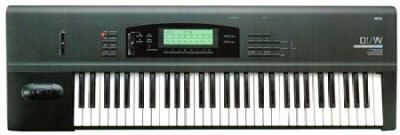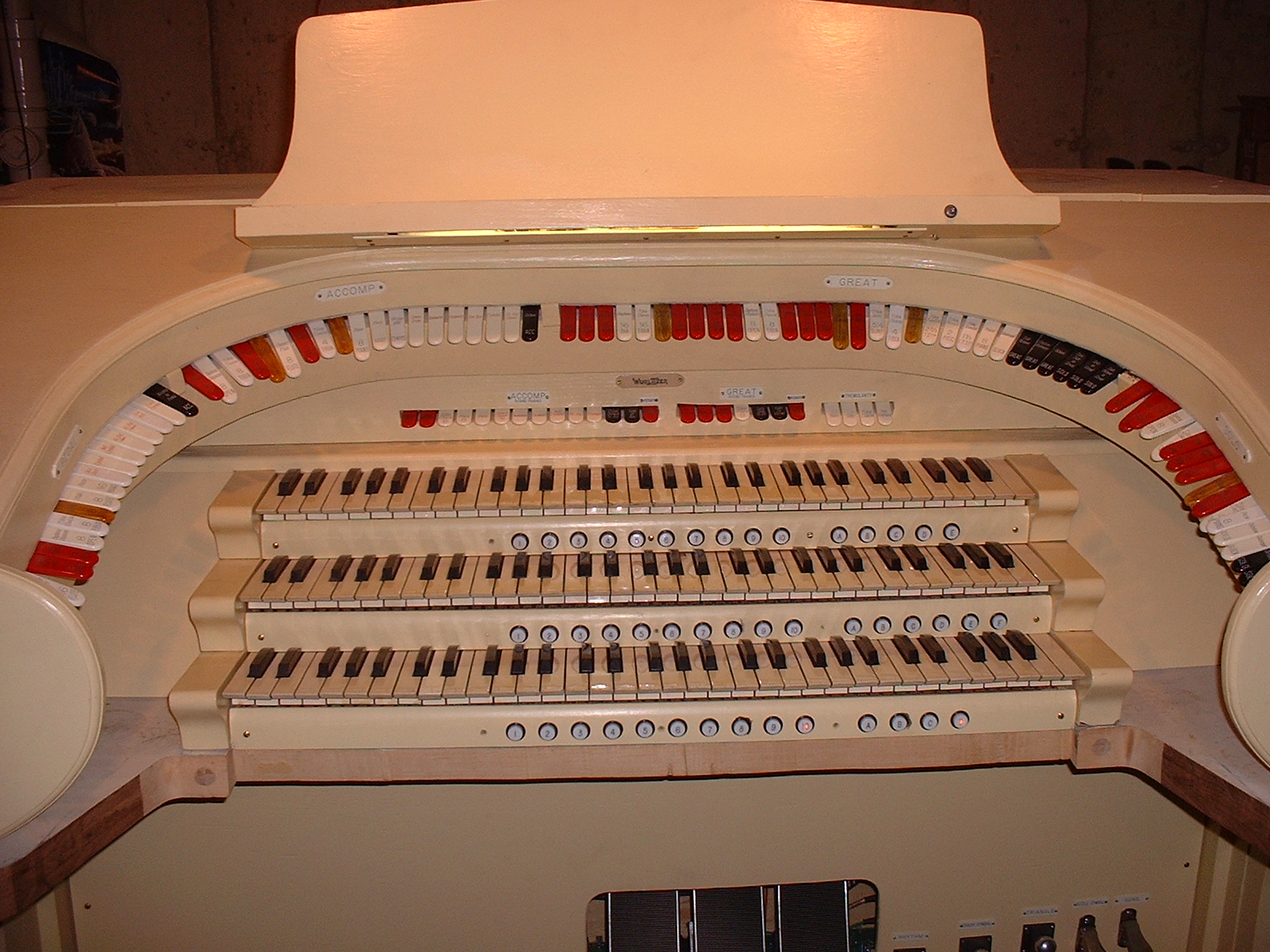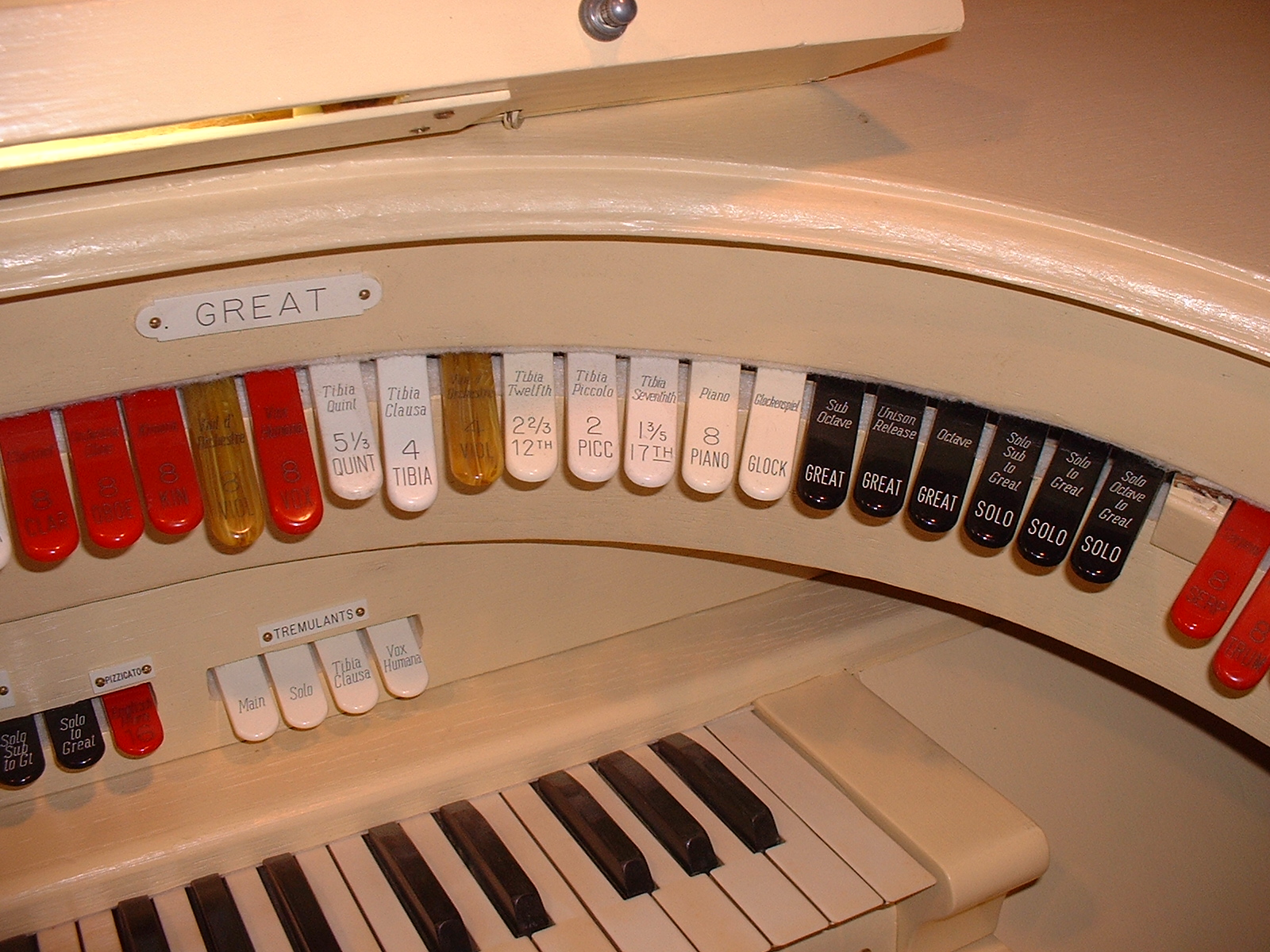HOW A VIRTUAL THEATER ORGAN OPERATES

Although synthesizers and samplers can do a pretty good job of SOUNDING like a
theater pipe organ, in their native form, they sure don't OPERATE like a theater pipe organ. First of all there is the
matter of stops. When playing an organ, you can alter the sound a given manual makes one voice at a time simply by turning
various stops on and off. For instance, if you are playing a chorus of strings and want to add a single Tibia voice to the
chorus, you push down the Tibia tab of your shoice, Simple as that.  The string stops are unaffected, and the only thing changed is the addition of that single Tibia stop. Using the stoptablets, you can change a PORTION of the sound.
If you want to change the ENTIRE sound rather quickly, you push a COMBINATION PISTON. This changes ALL of the stops on a
given division at once.
The string stops are unaffected, and the only thing changed is the addition of that single Tibia stop. Using the stoptablets, you can change a PORTION of the sound.
If you want to change the ENTIRE sound rather quickly, you push a COMBINATION PISTON. This changes ALL of the stops on a
given division at once.
Unfortunately, synthesizers as a rule do not have the facility to ALTER a stop setting or REGISTRATION one stop at a time.
Synthesizers change their sounds by changing what PATCH is being played. This is an ALL OR NOTHING operation. Pressing a
Synthesizer PATCH button changes the ENTIRE sound, just like a COMBINATION PISTON. If you had a string chorus playing like
in the above example and wanted to add a Tibia stop to it, you would have to select a synthesizer PATCH that contained the
string chorus with that Tibia stop added.
The best comparison I can make between selecting sounds on a synth and selecting sounds on a theater pipe organ is that
the synth is like an organ with NO STOPTABS, but a huge COMBINATION ACTION. You can only 'register' or select sounds for the
manuals and pedals by selecting PATCHES or in organ terms: COMBINATIONS. If you are hooking up an organ console to synths,
it makes sense to make the console's COMBINATION PISTONS control the synth's MIDI PROGRAM CHANGES.
On pipe organs and some electronic organs, the COMBINATION ACTION can be either MOVEABLE or BLIND. The MOVEABLE action
physically moves the stop tablets, both changing the sound and giving the player a visual indication of what will be heard.
This type of action also lets the player MODIFY the combination after selecting it by manually changing some stops. The other
type of combination action is the BLIND action. This action does NOT physically move the stops, but merely changes the sound
without giving any indication at the stoprail what the sound was changed TO. At best there are lighted indicators somewhere
showing the player what BLIND COMBINATION was selected, and also telling the player why the stoprail is no longer active.
Organ consoles that directly control synths, as in my Virtual Theater Organ have by necessity a BLIND combination
action. There are several ways to compensate for this. The first is that with synths, the player is not limited to the
usual 10 combinations found on WurliTzer theater organs. Even the 4 manual 36 Rank Fox Specials had only 10 pistons per
manual. (of course you could set individual stops) My Virtual Theater Organ has 60 COMBINATIONS available on the Great
manual alone. This is accomplished by having the usual pistons numbered 1-10, and in addition 6 BANK pistons labeled A-F.
Look at the picture above and to the right. Both types of pistons are illuminated so the player is always aware of the BANK
and COMBINATION selected. In operation, a BANK is initially selected (the system 'wakes up' on bank A) with pistons A-F,
and a COMBINATION is selected with pistons 1-10. As long as the player keeps using the same bank, only the pistons 1-10 need
to be pressed, as in a conventional combination action. In other words, one press of a button changes a sound. If it is
desired to change banks, the BANK piston is first pressed, and at that point the new BANK piston is illuminated, but
soundwise, NOTHING changes...yet. The next press of pistons 1-10 will select a sound in the NEW Bank that was just set.
This can be handy because registration changes as a rule are ALWAYS made in a hurry. If you know in advance that you are
going to change to a COMBINATION in a new BANK, press the BANK button whenever you have a convienent break in playing.
No sound changes, but you are ready to make both that BANK and COMBINATION change with a single press of a piston, exactly
when you need it. My Virtual Theater Organ has 60 COMBINATIONS on the Great manual, 50 on the Solo and 40 on the
combined Accompaniment and Pedal. My 3 Manual 25 Rank organ has more combination pistons available than the 4 Manual 36
Rank WurliTzer Fox Specials.
The second compensation for the BLIND action is that each COMBINATION and BANK piston is illuminated. I find this
absolutely necessary to keep track of what is playing where. The system takes a little getting used to, but is actually no
different than someone playing a large instrument with a big console, and registering with pistons only. A bunch of
organists do that. If the combinations are carefully programmed in advance, another advantage in this system is that you
never get a 'clinker' registration. Everything will sound good because you programmed it that way in advance.
The Korg synths work internally somewhat like an organ with a COMBINATION ACTION. There are individual PROGRAMS that are
set up internally within the synth, and each one of these represents a single voice or STOP, such as a Tibia, Vox, Posthorn,
or whatever. This is where all the sound programming happens: the waveform is selected, waves are shaped, filtered, and the
default pitch is selected. In all but a few cases, I set the PROGRAMS to play at 8' by default. When you press a COMBINATION
PISTON on the console, you are selecting what Korg also calls a COMBINATION. This is a synth PATCH that can consist of up
to eight of the PROGRAMS played together, so it's like a COMBINATION PISTON that can select up to eight STOPS. (on the Great
manual, which plays TWO Korg 01's, 16 stops are available) Within the COMBINATIONS, the programmer can select volume, pitch,
compass or range of the stop and several other parameters for each of the programs. Another selection is the MIDI channel
that will play the individual PROGRAM. There are more things such as effects (reverb, chorus, etc.) to be used, but these
stay constant for all voices, and explaining them here would just overly complicate stuff. MIDI channel selection is
indespensible for the synth that controls both the Accompaniment manual and Pedals. The manual voices are set
on one channel, the Pedal voices on another. Manual compass can be used to limit the range of tuned percussions or to
faithfully reproduce changes in timbre of some stops. Examples are the change from open to stopped pipes in the tenor octave
of the WurliTzer Concert Flute, or the change from reed to flue pipes in the higher octaves of chorus reeds. If someone is
setting up a COMBINATION to play Tibias at 16' 8' and 4', all that has to be done is put the Tibia PROGRAM in the first
three 'slots' of 'timberes' as Korg calls them, set the first to 16' (-12 notes pitch shift), leave the second one alone
(default 8'), and set the third one to 4' (+12 notes pitch shift). That's all there is to it. With practice you can actually
set COMBINATIONS on the synths about as fast as on a setter board on a pipe organ.
 To make the system more versatile, I have incorporated standard manual and pedal couplers into the organ. As far as I know,
mine is the only synth based Virtual Theater
Organ to do this. My keying system (see Construction) works on +3
volts DC, similar to a pipe organ, but with a lower voltage. I am able to use the same type of logic and switching that a
pipe organ uses to couple manuals to themselves at various pitches, and to couple one manual to another. Although pipe
organs have used electromechanical 'gang switches' to do this for a century, the recent trend is to accomplish this
electronically. My coupler switches utilize diode/resistor logic. Coupler control is done with stoptablets right on the
horseshoe rail, as seen in the picture to the right. This picture shows Great manual couplers as black tabs on the horseshoe
rail and Great 2nd Touch couplers as black tabs on the front rail (straight) rail. I have more couplers than the
average theater organ, more like the coupler stack found on most church organs. With a well unified theater organ controlled
by individual stop tabs, you don't have as much of a need for these. Since I do not have individual stop control, the
versatility these couplers give me is very welcome. See Specifications for a full list of
the couplers. Notice that many are available on Second Touch. So why do I have a complete set of stoptablets on the horseshoe
rail when they are mostly dummies? Because it gives a rough approximation of the actual 'organ' being controlled, and the
console just didn't look right without them.
To make the system more versatile, I have incorporated standard manual and pedal couplers into the organ. As far as I know,
mine is the only synth based Virtual Theater
Organ to do this. My keying system (see Construction) works on +3
volts DC, similar to a pipe organ, but with a lower voltage. I am able to use the same type of logic and switching that a
pipe organ uses to couple manuals to themselves at various pitches, and to couple one manual to another. Although pipe
organs have used electromechanical 'gang switches' to do this for a century, the recent trend is to accomplish this
electronically. My coupler switches utilize diode/resistor logic. Coupler control is done with stoptablets right on the
horseshoe rail, as seen in the picture to the right. This picture shows Great manual couplers as black tabs on the horseshoe
rail and Great 2nd Touch couplers as black tabs on the front rail (straight) rail. I have more couplers than the
average theater organ, more like the coupler stack found on most church organs. With a well unified theater organ controlled
by individual stop tabs, you don't have as much of a need for these. Since I do not have individual stop control, the
versatility these couplers give me is very welcome. See Specifications for a full list of
the couplers. Notice that many are available on Second Touch. So why do I have a complete set of stoptablets on the horseshoe
rail when they are mostly dummies? Because it gives a rough approximation of the actual 'organ' being controlled, and the
console just didn't look right without them.
Home
Background
Construction
Circuitry
Specifications
Virtual Theater Organ Registration Basics-Families of Theater Organ Tone
Virtual Theater Organ Registration Basics-The Tibia/String Relationships
Virtual Theater Organ Registration Basics-Esemble Registrations
Virtual Theater Organ Registration Basics-The Polphony Problem
Virtual Theater Organ Music .mp3's
Email Me at steamrocks@yahoo.com
 The string stops are unaffected, and the only thing changed is the addition of that single Tibia stop. Using the stoptablets, you can change a PORTION of the sound.
If you want to change the ENTIRE sound rather quickly, you push a COMBINATION PISTON. This changes ALL of the stops on a
given division at once.
The string stops are unaffected, and the only thing changed is the addition of that single Tibia stop. Using the stoptablets, you can change a PORTION of the sound.
If you want to change the ENTIRE sound rather quickly, you push a COMBINATION PISTON. This changes ALL of the stops on a
given division at once.
 To make the system more versatile, I have incorporated standard manual and pedal couplers into the organ. As far as I know,
mine is the only synth based Virtual Theater
Organ to do this. My keying system (see
To make the system more versatile, I have incorporated standard manual and pedal couplers into the organ. As far as I know,
mine is the only synth based Virtual Theater
Organ to do this. My keying system (see